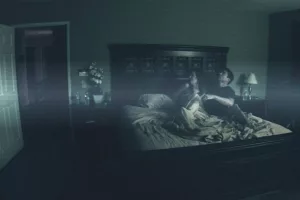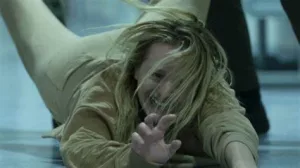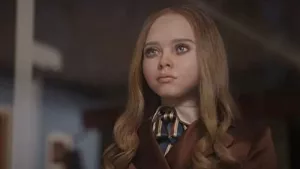Uncovering the Secrets Behind Blumhouse’s Success: A Low-Budget, High-Profit Approach to Horror Film Making
One of the biggest brands in horror these days has got to be Blumhouse, the production company known for its low-budget, high-profit horror films like “Paranormal Activity,” “Get Out,” and most recently, “M3GAN.” The company’s model involves producing horror films with relatively small budgets, usually in the range of $3 million to $5 million, but with the potential for large returns if the films are successful. Blumhouse achieves this by keeping costs low through tight schedules, efficient shooting processes, and focusing on practical effects and suspense over expensive special effects. Lean and mean, it’s been told by creatives that have gone through the Blumhouse process, but it’s also the partnerships with major studios that allow them to reach a large audience while minimizing their marketing costs. The result? Huge horror franchises, including “Paranormal Activity,” “The Purge,” and “Insidious,” dominating theaters, VOD, and streaming!
When you look at it, you can chalk up Blumhouse’s success in producing horror films to several key factors:
- By keeping budgets low, Blumhouse can minimize financial risk and increase the potential for profit if a film is successful.
- Blumhouse puts a strong emphasis on building suspense through storytelling and practical effects rather than relying on expensive CGI. This keeps production costs low per point number one, and helps to create a more immersive experience for the audience.
- Blumhouse’s focus is on a highly efficient and streamlined production process. This helps the company to produce high-quality films in a relatively short amount of time, which keeps costs low and allows for more films to be produced. Assembly line is a bit harsh but it’s definitely intended to be an output factory!
- Blumhouse has established partnerships with major studios for the distribution and marketing of their films. This allows them to reach a wide audience without incurring the significant costs of a large marketing campaign.
In comparison, other production companies may have larger budgets for their horror films, allowing for more elaborate special effects and higher production values. However, this also increases the financial risk and may result in a less profitable outcome if the film is not well-received by audiences. So at the end of the day, Blumhouse throws lots of products out into the marketplace, and if 1 out of 10 hits, it makes up the cost on the other nine and then some!
One of Blumhouse’s first success stories was, of course, “Paranormal Activity” in 2007. This found footage-style horror film became a cultural phenomenon and one of the most profitable films ever. It resonated with audiences due to its low-budget, stripped-down approach to horror and its use of suspense and jump scares to create a sense of unease.
“Paranormal Activity” was a huge success as the film was made on a budget of just $15,000, which made it an attractive investment for Blumhouse as the potential for profit was high if the film was successful. The low budget also allowed the filmmakers to be more creative and resourceful, as they had to rely on suspense and practical effects to build tension. Even in a post-Blair Witch world, the found footage style of the film was relatively new in 2007 and helped to create a sense of immediacy and realism. The film’s slow burn approach to horror, with the tension building gradually over time, was also a departure from traditional horror films that relied on jump scares and gore.
The film was initially released in a limited number of theaters and relied heavily on word of mouth to build buzz. The marketing campaign included a clever viral marketing campaign that encouraged fans to request screenings in their local theaters. This all led to “Paranormal Activity” becoming a cultural phenomenon and was one of the most talked-about films of the year. It spawned several sequels and imitators and helped to popularize the found footage style of horror filmmaking.
After the success of “Paranormal Activity,” Blumhouse continued refining its production strategy and began to work with more high-profile talent, both in front of and behind the camera, to continue to produce high-quality films that resonate with audiences. “The Purge,” Jordan Peele’s “Get Out” and M. Night Shyamalan’s “Split” and “Glass” among many of its success stories.
And yes, some stumbles along the way. Some of Blumhouse’s biggest misses included “The Darkness,” “The Veil” and “The Gallows,” all films that both were savaged by critics and underperformed at the box office. But again, all it takes is one hit, and in partnership with Universal Pictures, delivered “The Invisible Man,” a modern reimagining of the classic H.G. Wells novel that was both a critical and commercial success.
Directed by Leigh Whannell and starring Elizabeth Moss, the film grossed over $124 million worldwide against a budget of $7 million and received positive reviews for its smart writing, engaging performances, and suspenseful direction. All of this laddering back to the secret sauce Blumhouse tends to infuse into all of its movies: “Low-Budget, High-Impact,” “Fresh Takes on Classic Themes,” “Smart, Grounded Stories,” “Effective Use of Practical Effects” and “Surprising Twists and Turns.” To break that down more, here’s how we see that playing out:
- Low-Budget, High-Impact: Blumhouse is known for producing high-quality horror films with low budgets, which allows for more creative freedom and a greater focus on suspense and storytelling.
- Fresh Takes on Classic Themes: Blumhouse is known for putting a fresh spin on classic horror themes and tropes, which keeps the genre fresh and exciting.
- Smart, Grounded Stories: Blumhouse films often feature intelligent, well-written stories grounded in real-world fears and anxieties. This makes the films more relatable and effective at generating suspense.
- Effective Use of Practical Effects: Blumhouse is known for using practical effects in its films, which can make the scares feel more natural and intense.
- Surprising Twists and Turns: Blumhouse films often feature surprising twists and turns that keep audiences engaged and on the edge of their seats.
This leads us to their most recent hot property horror release, “M3GAN.” The film, which debuted on January 6th and was a collaboration between Blumhouse and James Wan’s Atomic Monster, has been making waves at the box office with impressive numbers. The film, which stars Allison Williams as a robotics engineer named Gemma who becomes the guardian of her recently orphaned niece and decides to make her the test subject for her latest creation, an artificially intelligent android named M3GAN, has been a hit with audiences.
The film more than quintupled its budget of $12 million, generating more than $91 million globally, as the horror genre continues to surge in popularity. The film’s strong opening, outpacing last year’s “Scream,” and “Smile,” indicates that 2023 will be another great year for the genre. “M3GAN’s” success off a completely original idea bodes well for upcoming horror franchises such as “Scream VI,” “Evil Dead Rise,” “The Nun 2,” “The Exorcist,” and “Saw X,” which are all set to release later in the year.
And yup, get ready for more terror from “M3GAN” from the Blumhouse gang. The iconic artificial intelligence turned killer doll is set to return to the big screen with “M3GAN 2.0” on January 17, 2025… but Blumhouse will have other films, including the “Insidious” sequel “Insidious: Fear the Dark” coming this July to hold you over until then. Needless to say, the Blumhouse horror brand continues to burn brightly (darkly??) in 2023 and beyond and we can’t wait for more!
Ring Indoor Cam (newest model) — Home or business security in 1080p HD video, White
$59.99 (as of April 24, 2025 09:51 GMT -07:00 - More infoProduct prices and availability are accurate as of the date/time indicated and are subject to change. Any price and availability information displayed on [relevant Amazon Site(s), as applicable] at the time of purchase will apply to the purchase of this product.)New 2025 ecobee Smart Thermostat Essential - Energy Star Certified programmable Wi-Fi Thermostat - Works with Siri, Alexa, and Google Assistant
$129.99 (as of April 24, 2025 09:51 GMT -07:00 - More infoProduct prices and availability are accurate as of the date/time indicated and are subject to change. Any price and availability information displayed on [relevant Amazon Site(s), as applicable] at the time of purchase will apply to the purchase of this product.)Pet Steam Brush for Dog & Cat – 3-in-1 Spray Hair Removal Comb – Steam for Shedding & Grooming – Water Brush for Long & Short Haired Pets – Spritz Defur Comb – Includes Waterless Shampoo
$24.99 (as of April 24, 2025 09:51 GMT -07:00 - More infoProduct prices and availability are accurate as of the date/time indicated and are subject to change. Any price and availability information displayed on [relevant Amazon Site(s), as applicable] at the time of purchase will apply to the purchase of this product.)ZZSTAR 12x32 Large View Binoculars with Camera, FMC & BAK4 Prism Binoculars for Adults High Powered, 2" LCD Display 5MP 1080P Video Photo Recorder for Bird Watching Hunting, with 32GB Card, Silver
$89.99 (as of April 24, 2025 09:51 GMT -07:00 - More infoProduct prices and availability are accurate as of the date/time indicated and are subject to change. Any price and availability information displayed on [relevant Amazon Site(s), as applicable] at the time of purchase will apply to the purchase of this product.)Stitch Gun for Clothes - Mini Stitch Gun Refills -Tagging Gun for Clothing - Sewing Kit Includes 6 Needles 1000 Black Fasteners and 1000 White Fasteners (Pink)
$21.99 (as of April 24, 2025 09:51 GMT -07:00 - More infoProduct prices and availability are accurate as of the date/time indicated and are subject to change. Any price and availability information displayed on [relevant Amazon Site(s), as applicable] at the time of purchase will apply to the purchase of this product.)Auto Amazon Links: No products found. (72 items filtered out)













 OpenCritic
OpenCritic